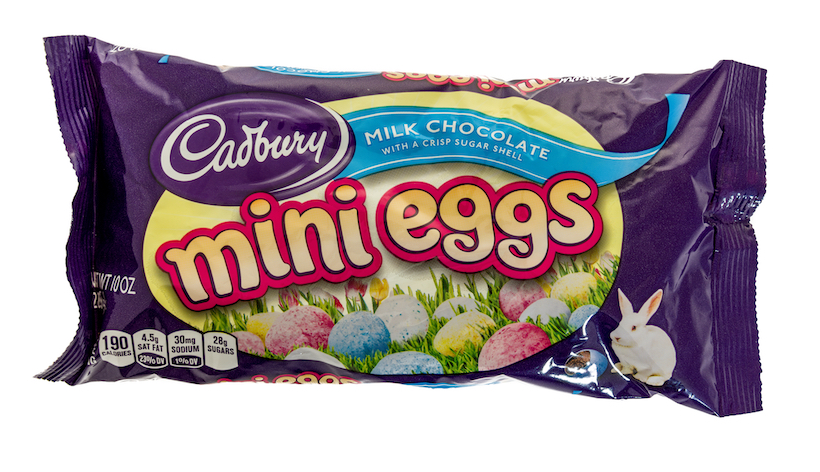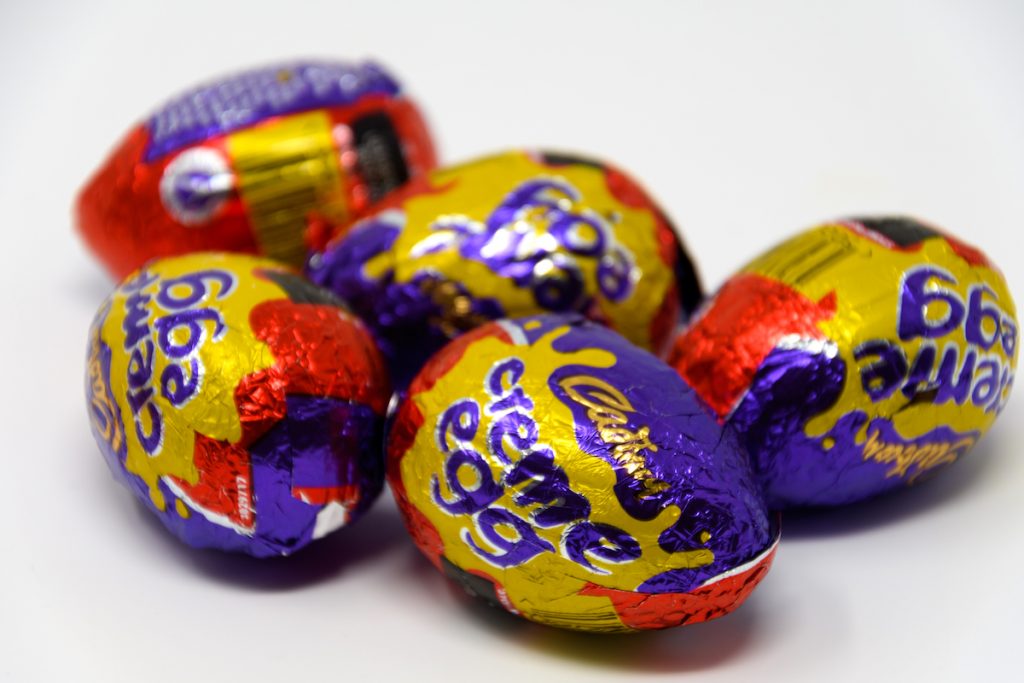Cadbury Eggs are a delicious springtime treat and Easter egg delicacy... or a loathsome attack on the tastebuds, depending on who you ask. As it turns out, Cadbury Eggs' history is just as controversial, mostly because the recipe isn't standardized between countries.
Since the company's 1824 founding by John Cadbury in Birmingham, England, its products have gone through many recipe – and ownership – changes. So let's crack the chocolate shell, dive into that ooey-gooey center, and find out what makes Cadbury Eggs so popular and controversial.
The Cadbury Creme Egg has a milk chocolate shell and a soft, fondant filling. Cadbury confectioners add yellow food coloring to the creme center to mimic an egg yolk, which is part of what makes the candy such an iconic Easter season treat.
Most people think that Cadbury injects the filling into its eggs, but this is not the case. First, the candy makers mold the chocolate shell into two halves of an egg. They then fill the two halves with the sugary fondant and sandwich them together using a device called a book mold.
Cadbury Eggs's roots date to 1824 with John Cadbury, who opened up a small candy shop in Birmingham, England. He sold tea, coffee, and – more importantly for our story – drinking chocolate. Once his shop found success, Cadbury took his chocolate ventures to a new level when he and his brother opened a cocoa factory in 1831.
Competition breeds innovation, and that's precisely what happened when Joseph Fry stepped on the scene. His company, J. S. Fry & Sons, became chocolate's largest commercial producer in the United Kingdom. Naturally, this made him a formidable competitor to the Cadbury brothers. In 1847, Fry began experimenting with a moldable chocolate bar suitable for large-scale production.
This naturally encouraged the Cadbury brothers to do some experimenting of their own. In 1865, Cadbury created the first chocolate egg made with dark chocolate and filled with "dragees," or sugar-coated chocolate drops.
Their competition ended in 1919 when Cadbury and Fry merged to create the British Cocoa and Chocolate Company. With their talents and resources combined, they would go on to start manufacturing cream-filled eggs in 1923.

It wasn't until 1963 that the first versions of the modern Cadbury Creme Eggs were born. Sold initially as Fry's Creme Eggs, they took the Cadbury Creme Egg name in 1971 after Cadbury company merged with the drink company Schweppes to form Cadbury Schweppes (in 1969).
The 21st century ushered many controversial changes to the Cadbury company – both corporate ownership and proprietary formulas and ingredients. A demerger from Schweppes eventually led to Kraft Foods' ownership in 2010, which soon split off Cadbury as a subsidiary of Mondelez International.
Regional laws, practices, and preferences mean that not all Cadbury Eggs are the same. If you were to eat Cadbury Eggs from different regions in one sitting, you would definitely notice the differences.
In fact, the regional adjustments have historically caused more than a few controversies. Cadbury fans in Australia were up in arms when the company made a 2009 recipe change from cocoa butter to palm oil for their market, for example.
Even though you can find subtle differences between Cadbury Eggs produced in (or for) most other countries, it's safe to say that the most controversial rivalry exists between the U.S. and U.K. varieties. A 2015 article in U.K.'s The Guardian expressed the British disdain for the American knock-off egg: "There are two differing Creme Eggs. There is the UK-manufactured flagship, a full 40g of chocolatey egg glory. Then there is its American, dear-god-hide-it-in-the-attic sibling, a wretched creature offering a mere 34g of satisfaction."
Some of it also comes down to who manufactures the Cadbury Egg – in many countries, it's not Cadbury. In 1988, The Hershey Company, known for its chocolate bars and other candies, acquired the U.S. Cadbury Egg license and began tinkering with the classic British recipe as it established CadburyUSA. Within the past decade, Hershey has also legally stopped the import of all British-made Cadbury products, which the company now sees as competitors as it enforces its licensing agreement.
Research indicates there are quite a few differences in the formulas between the Hersheys' Cadbury and the original British Cadbury Creme Eggs.
In the United States, corn syrup is the primary sweetener in the crème filling, but this isn't true for the British Cadbury Egg. The U.K. actually limits corn syrup's usage. The distinction creates a significant difference in the recipe and overall taste between the two.
The chocolate itself is another point of enormous contention between the two regions. In the United States, a spin-off of Kraft (Mondelēz) produces the chocolate, while Hershey's does the marketing. In the U.K., Cadbury makes its own chocolate.
Hershey's chocolate is extremely popular in the United States... but that doesn't appear to hold in the United Kingdom. Taste tests show that many U.K. consumers despise Hershey's chocolate, comparing the taste to wax and "over-sugared minimal cocoa butter garbage."
As a 2015 New York Times article reports, "Chocolate in Britain has a higher fat content; the first ingredient listed on a British Cadbury's Dairy Milk (plain milk chocolate) is milk. In an American-made Cadbury's bar, the first ingredient is sugar." Ah, but we Americans love our sugar, don't we?
However, the beloved dairy-milk recipe also went the way of the unicorn. This 2015 British article bemoans even the British recipe's switch from dairy milk and "whatever it is that goes into the cream/creme that forms the centre of a true Cadbury Creme Egg" to "standard cocoa mix chocolate" and other culinary tricks.

Actually, one of the very first Creme Eggs still exists today! An original Fry's Creme Egg from over 50 years ago was found in its original wrapper. Unfortunately, it on display, so we may never know how the genuine original tasted.
Over the decades, Cadbury Eggs have seen great success. Sales in the U.K. reach upwards of £200 million every year, so the Bournville factory in Birmingham makes sure there are plenty to go around. In fact, it manufactures 1.5 million eggs daily at that location alone.
These are big numbers considering that Cadbury Eggs are only available between January 1 and Easter Day. Cadbury attempted to sell the eggs year-round to capitalize on their success, but it didn't work out as expected. According to Cadbury spokesperson Tony Bilborough, there's just something special about a Cadbury Easter Egg, and part of that is waiting for "Creme Egg season" to come around. In short: they simply don't sell as well when you remove the seasonality. Kind of like pumpkin spice!
Luckily, you might find a Cadbury Creme Egg a few other times of the year – but it won't be labeled as the classic egg to which you may be accustomed.
For example, there's the Screme Egg, a chocolate egg with a green yolk sold around Halloween. Besides holiday varieties, you may find countless other versions and forms of the cream egg, including Caramel Eggs, Mini Creme Eggs, Jaffa Eggs with dark chocolate, and even a McDonald's Cadbury McFlurry.
Today, Cadbury uses memorable advertising campaigns to spread the word about the Cadbury Creme Egg and make its mark on the Easter season. Many of us remember the iconic 1982 "clucking bunny" commercial, where a cute little bunny lays a nest full of Cadbury Creme Eggs. It is so iconic that the company announced it would be updating the commercial for the first time in 35 years.
Cadbury elevated the Egg's fame even further when they launched the "How Do You Eat Yours?" campaign in 1985. The ad campaign sparked a lighthearted debate between Cadbury Creme Egg lovers everywhere on the proper way to eat a Cadbury Creme Egg.
Do you eat it all in one bite? Or do you crack through it like a soft-boiled egg and eat the filling with a spoon?
Cadbury even conducted a survey of its own to find out the truth, and here are some of the results:
While the Cadbury Egg has had more than its fair share of successes, it has also seen many controversies.
In 2015, Cadbury discovered what happens when you mess with a nostalgic childhood favorite. Outrage erupted in Britain when Cadbury announced it was making changes to the beloved Cadbury Creme Egg packaging and recipe.
For starters, the company reduced the number of eggs included in every package from six to five. While this might have been forgivable, it was the change to the chocolate recipe that proved most upsetting. For over forty years, Cadbury used dairy milk chocolate for their eggs. When the company announced it would be switching to a "standard cocoa mix chocolate," it proved to be a controversial swap for the fans of the original.
In the end, Cadbury paid for its mistake... quite literally. The company experienced a £6 million drop in sales the year after the recipe change.
Another major controversy surrounds the size of the Cadbury Egg. Many believe that Cadbury Creme Eggs have been shrinking right before our eyes and mouths over the years.
When asked why the egg was shrinking, Cadbury offered a sassy answer on its FAQ page back in 2003: "It hasn't—you've just grown up!"
Not too bad, and they might have gotten away with it, too, if actor B.J. Novak hadn't stepped up with proof to settle things once and for all.
Novak appeared on Conan O'Brien's late-night talk show in 2007 and brought two Cadbury Creme Eggs. When he held one from 2005 and another from 2007 side by side, nobody could argue that the egg from 2005 was a bit bigger. The proof was in the pudding (or, in this case, the shiny foil wrapper):
I usually bite into the smaller side first – but after researching the topic in depth, I realize now that even my eating approach is controversial.
However you like to eat yours (or even if you're a Cadbury Egg-avoider), I hope you enjoyed the post, and learned a thing or two about the incredible Cadbury Cream Egg.